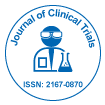
Journal of Clinical Trials
Open Access
ISSN: 2167-0870

ISSN: 2167-0870
S. Mehkri, K.G. Dinesh, G. Ashok and Krathish Bopanna*
Background: Lutein and Zeaxanthin (LZ) support macular function, but oral absorption is limited by intestinal solubilization and uptake; phospholipid environments may improve micellization and enterocyte transport.
Objective: To evaluate whether an anionic Phosphatidylserine (PS) matrix enhances single-dose LZ exposure compared to Phosphatidylcholine (PC), a reconstituted liposomal powder, and Medium-Chain Triglyceride (MCT) oil in rats.
Methods: Male Sprague-Dawley rats (n=6 per group) received oral gavage of dose-matched lutein (10 mg/kg) in four matrices (MCT, MCT+PC, MCT+PS, liposome); serial plasma samples (0-24 h) were analysed using validated LC-MS/MS (calibration 5-250 ng/mL). Noncompartmental pharmacokinetics were calculated; group differences in Cmax and AUC?–t were evaluated via one-way ANOVA with Dunnett contrasts versus MCT.
Results: LZ exposure followed the order PS > PC ≈ liposome > MCT. Cmax (ng/mL, mean ± SD): 52.54 ± 0.70 (MCT), 60.45 ± 1.24 (PC), 69.63 ± 0.78 (PS), 62.39 ± 1.12 (liposome). AUC?–t (ng·h/mL): 494.51 ± 13.70 (MCT), 596.37 ± 30.29 (PC), 620.23 ± 16.41 (PS), 536.70 ± 18.42 (liposome). Dunnett vs MCT: PS p<0.001; PC and liposome p<0.01. T_max was approximately 2 hours for PS/PC versus about 3 hours for MCT/liposome; half-life was similar (~7.7-8.3 hours).
Conclusions: Anionic PS oils increase LZ exposure and bioavailability more effectively than PC or liposomal powder at equal doses, without altering elimination.
Published Date: 2025-11-28; Received Date: 2025-10-29